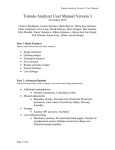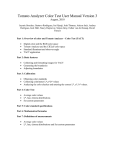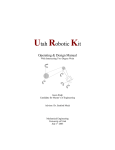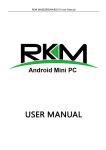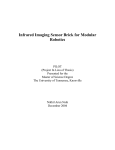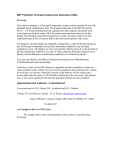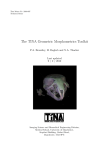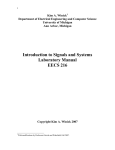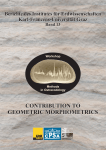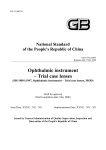Download Tomato Analyzer User Manual Version 2.2.0.0
Transcript
Tomato Analyzer User Manual Tomato Analyzer User Manual Version 2.2.0.0 February, 2008 Marin Brewer, Gustavo Rodriguez, Maria Jose Gonzalo, Claire Anderson, Lixin Lang, David Sullivan, Nancy Dujmovic, Kikuo Fujimuro, Simon Gray, Esther van der Knaap Part 1: Basic Features Step by step instructions for basic analysis • • • • • • • Image collection Opening images Automated analysis Save function Results and data window Export functions User Settings Part 2: Advanced Options Advanced operations, such as image corrections and setting adjustments • Additional manipulations • Internal eccentricity, Latitudinal section, Color analysis • Manual adjustments • Boundary, Rotate, Proximal end, Distal end, Distal end protrusion, Auto-rotate, Adjust ellipse, Adjust pericarp boundary • Settings • Scanner DPI, Measurements saved • User-defined settings • Blockiness position, Macro/micro level, Number of morphometric points, Default ellipse size, Default pericarp boundary Note: Tomato Analyzer runs on a Windows operating system (2000 or higher). Page 1 of 18 Tomato Analyzer User Manual Part 1: Basic Features Image collection Objects should be scanned with a black background. This prevents shadows from interfering with the analysis. Dark objects, such as leaves, may need to be scanned with a white background for contrast, but shadows will need to be eliminated. The image also needs to be cropped during scanning or later with imaging software such as Adobe Photoshop. The Tomato Analyzer software will attempt to find objects throughout the image and if most of the image is empty (i.e. no objects) the software will not work properly. The software is sensitive to image resolution and object size. Most fruits from 1 cm to 8 cm can be scanned and analyzed at 300 dpi (pixels/inch). If the fruits are large (> 8 cm), the resolution of the original image should be adjusted to approximately 100 dpi or smaller. The resolution of the original image needs to be set to approximately 750 dpi or larger in order to analyze very small objects, such as seeds. For accurate analysis, the dpi setting on Tomato Analyzer needs to be set to the same value as the images. See Part 2, “Settings: Scanner DPI” of this manual. If analyzing multiple images at once (see Part 1, “Export functions”), it is best that all images are saved at the same resolution. Opening images Start the Tomato Analyzer program and click on the “Open image” button. Select and open the image file from the pop-up dialog box. The selected image will be displayed in the left window. Page 2 of 18 Tomato Analyzer User Manual Automatic analysis Prior to the analysis, the user needs to set the dpi and measurement units to the appropriate settings by selecting “Scanner DPI” from the “Settings” menu. The dpi setting needs to be the same as the image file so that the size measurements (height, width, perimeter, area) are accurate. The “Units used” in the dialog box determines the units (cm, mm, in, or pixel) for the data output. Also, the user must select the attributes to be measured (see Part 2, “Settings: Measurement saved” in this manual). When blockiness, triangle, distal and proximal end angle are being measured, the user will have to choose settings for these attributes (see Part 2, “Settings: Blockiness position” and “Macro/micro level” in this manual). In addition, settings for “Morphometric Points” (for the morphometric or geometric analyses), “Default ellipse size” (for the internal eccentricity) and “Color test” will need to be selected if these attributes are to be measured. When the settings are not adjusted by the current user, the images will be analyzed at the settings that were chosen by the previous user. button. When To analyze the opened image, click the “Analyze” finished, the perimeter of each fruit will be highlighted with a yellow line and the data will be displayed in the lower-right data window. The software will automatically deselect very large or small objects, such as a ruler or label. Additional fruits can be deselected by right clicking on them. Only items outlined in yellow will be displayed in the data window or exported. Items outlined in blue will not be included in any analyses. Individual fruits are displayed in the upper-right window by left-clicking on them with the mouse. Data window Page 3 of 18 Tomato Analyzer User Manual Save function Click on the “Save Fruit” button. All current information, including manual adjustments and deselected objects, will be saved as a tmt file. The name of the file is the same as that of the original image except it has a different extension (tmt). Every time a file is selected, the saved tmt file with the same name will automatically be opened because it is linked to the original file. The tmt file should appear in the same folder as the jpg image file. To revert to the original image file, without any of the adjustments, simply delete the associated tmt file. An alternative is to select “Analyze” to reanalyze the original image. However, beware that any tmt with the same name as the image will still be associated with the image the next time that the file is opened unless, of course, adjustments are saved over the tmt. Results and data window Shape attributes are divided into ten groups: Basic Measurements, Fruit Shape Index, Blockiness, Homogeneity, Distal Fruit End Shape, Proximal Fruit End Shape, Asymmetry, Internal Eccentricity, Latitudinal Section, and Morphometrics. By default, the “Basic Measurement” group is displayed. To view another group, click on the tab of the corresponding group. For detailed explanations of shape attributes, see the measurement reference document, “Tomato Shape Analysis”. Each row of data in the window corresponds to a particular fruit. The data is displayed in the same order as the objects in the image. The first row displays the values of the object in the upper left hand corner and the last data row displays the values of the object in the lower right corner of the image. Click on a row to display the corresponding fruit in the top window on the right. Alternatively, click on a fruit and the corresponding data row will be highlighted. By clicking on the attribute tab in the lower-right window it is possible to view how that attribute is being measured for each particular fruit. For example, by clicking on distal end angle, the angle measured by the software for all of the fruits in the left window will be shown. This feature is very useful when identifying objects that require manual adjustments (see Part 2, “Manual adjustments”). Page 4 of 18 Tomato Analyzer User Manual Export functions The user can export data for an individual image by selecting the button. The data will be exported to an Excel file and display the values for each fruit, the average and the standard deviation. The “Batch Analysis” function is used to export the values of the attribute from two or more images. Click on the “Open Image” button. Select the image files to be batch analyzed. Multiple files are selected using the “Shift” or “Ctrl” key while selecting additional files. After the files are selected, click on the “Open” key. The user will be asked to select the type of batch analysis output: Average Only, Average and Standard Deviation and Individual Measurements per image. Choose a name for the Excel file that will be created and click on the “Save” key. The software will automatically open the files and begin the batch analysis. If the image files have been previously analyzed and saved by Tomato Analyzer, the saved files (tmt) will be opened for the batch analysis. If the files have not been previously analyzed, the software will perform the analysis with the original images. If the files were analyzed with an older version of Tomato Analyzer, the user will be prompted to save the images as tmt for each image in the batch. The application will then recalculate the existing as well as analyze new attributes. The software may crash if too many images have been chosen for batch analysis. If this happens, select fewer files in subsequent analyses. User Settings This feature allows the user to apply exactly the same measurements at the selected settings for blockiness, triangle, distal and proximal end angle, number of morphometric points, default ellipse and/or color to a population analyzed at another time by the same or another user. To save the settings for later use select “User settings: save settings” from the “Settings” menu. A file dialog will pop up, prompting the user for a name for the user settings file (*.ctmt). The user can save the file anywhere on their computer. The saved settings can be loaded by choosing “User settings: Load settings” from the “Settings” menu and locating the settings file. Page 5 of 18 Tomato Analyzer User Manual Part 2: Advanced Options Additional manipulations Whereas most features of Tomato Analyzer are measured using the external boundary of the objects, shape attributes of internal features can be measured as well. Tomato Analyzer allows the user to draw an ellipse on the object around the feature of interest. Several measurements can be taken using the dimensions of the ellipse and the outer boundary. Internal Eccentricity This feature was developed to measure the degree of fruit eccentricity of longitudinally cut fruit. The user can set the “Default ellipse size” in the “Settings” menu to approximate the features to be measured (see image below). After the default size, the user can adjust each ellipse manually using the “Adjust ellipse” function in the “Revise” button (see: “Adjust ellipse” in the “Manual adjustments” section, and “Default ellipse size” in the “User defined settings” of this manual). Tomato Analyzer will measure various eccentricity features from the ellipse and the boundary of the object. Page 6 of 18 Tomato Analyzer User Manual Latitudinal section The “Latitudinal section” tab houses features that are measured in cross sections of the tomato fruit. The attributes are called: “Pericarp area”, “Pericarp thickness” and “Lobedness Degree”. The pericarp attributes measure thickness of the walls of the tomato fruit. To set the pericarp boundary, select a fruit to appear in the upper right corner and use the “Default pericarp boundary” feature in the “Revise” button. The pericarp thickness varies per fruit therefore the user can select a default specific for each object in the image. The default setting will result in a boundary that is a fraction of the outer boundary. The pericarp boundary can be further adjusted via the “Adjust pericarp boundary” feature (see also: “Manual adjustments” in this manual). The “Pericarp area” and “thickness” features can also be used to measure placenta and columella area. Be aware that when saving the tmt with another measurement, e.g. from pericarp area to placental area, the boundary for the placental area will be saved over the pericarp area. “Lobedness degree” does not require manual manipulations and is measured automatically. Color analysis This feature was developed to assess fruit color and color uniformity of cut tomato. To analyze color uniformity, the percentage of red and white area can be calculated using the color test feature in the “Settings” menu. Tomato Analyzer will check each pixel of the tomato slice to see if it is “red” or “white”. The color of the pixels is measured using both the RGB and HSL color scales. In order for a pixel to be red, the pixel should have a low hue value. The user needs to define this range, which is [0, hue], where hue is the highest hue value that is considered to be red. Likewise, the user needs define what makes a pixel white by finding its luminosity value. A pixel that is “white” has a high luminosity value and the user needs to provide the range [lum, 240], where lum is the lowest luminosity value that is still “white”. The border or skin of the fruit (see image below) should not be included in the calculation of red-white percentages. Therefore, the minimum blue value needs to be set so that only the cut surface will be analyzed for the red-white percentages. By default, minimum blue value is 0. Color analysis output produces a CSV file with the average RGB, Hue and Luminosity values of each tomato slice, along with the percentages of the “white” and “red” area. Batch analysis can be used for color analysis also. If “batch” is checked in the “Settings, color test” box, Tomato Analyzer will prompt the user for selecting images for batch analysis. If batch is not checked, TA will analyze the current image and save it in a CSV file. For more details see also Color Test User Manual at http://www.oardc.ohiostate.edu/vanderknaap/TArelease.htm. Page 7 of 18 Tomato Analyzer User Manual Manual adjustments Occasionally the outline of the fruit and the proximal and distal ends are not found correctly by Tomato Analyzer. This would lead to incorrect results of many measurements. Usually this can be corrected through manual adjustment of the image and objects. The available adjustments appear under the “Revise” menu button and include: Rotate, Boundary, Proximal End, Distal End, Auto-rotate, Adjust Ellipse, Adjust Distal Protrusion, Adjust Pericarp Boundary, Default Pericarp Boundary. Note 1: The software functions best if the boundary is adjusted prior to any other manual adjustments. The rotation should be adjusted, if necessary, prior to adjustment of the distal and proximal ends and subsequent manual adjustments Note 2: An adjustment selected under the Revise menu remains selected until a different adjustment is chosen. This allows the user to perform the same adjustment on a sequence of slices by clicking on the slice image and clicking the Revise button. Page 8 of 18 Tomato Analyzer User Manual 1. Boundary To adjust the boundary: a) Click on the fruit in the left window. It will appear in the upper right window. b) Click the arrow next to the “Revise” button and select “Boundary” from the drop down list c) In the upper-right window, select the boundary location that needs to be modified. This is accomplished by left clicking on the start point and end point of the incorrect boundary. As a result, the delimited boundary will be removed (see figure below). d) To add a new boundary, left click from the start point toward the end point. Continue clicking to follow the desired contour. Right clicking will undo a previous modification. Multiple modifications can be undone by consecutive right clicks (see figure below). e) To confirm new boundary, press the “Enter” key. Otherwise, press the “Esc” key to cancel this operation. f) Click on “Reset Boundary” to return to the original boundary setting. Page 9 of 18 Original boundary Select the segment of the boundary that needs to be modified. Draw new boundary Adjusted boundary Tomato Analyzer User Manual 2. Rotate This feature is used when an object is not completely vertical. a) Click on the appropriate fruit in the left window. It will appear in the upper-right window b) Click the arrow next to the “Revise” button and select “Rotate” from the drop down list. c) An axis will be displayed in the upper-right window. Drag the green square at the end of the axis and the fruit will rotate accordingly. d) Double click inside of the window or press the “Enter” key to finish. e) Click on “Reset Rotation” to return to the original alignment. Original image After rotation 3. Proximal end If there is an error with the position of proximal end, the measurements derived from this feature will be incorrect. To efficiently find the fruit in an image that requires adjustments, select one fruit so that it appears in the window on the right. Select the “Proximal fruit end shape” tab and the “Proximal angle micro or micro” in data output section below the selected fruit. The proximal angles will now be shown for each fruit in the image on the left and angles that seem unusual can be found. To change the position of the proximal end: a) Click on the desired fruit in the left window. It will appear in the upper right window. b) Click the arrow next to the “Revise” button and select “Proximal End” from the drop down list. Page 10 of 18 Tomato Analyzer User Manual c) In the upper-right window, click and drag the vertex indicator to the correct position. d) Double click or press the “Enter” key to finish. Original image After adjust Proximal End 4. Distal end The position of the distal end of the object can also be changed manually. To efficiently find fruit that need distal end adjustments, follow similar directions that were described for the proximal end. To change the position of the distal end: a) Click on the desired fruit in the left window. It will appear in the upperright corner. b) Click the arrow next to the “Revise” button and select “Distal End” from the drop down list. c) In the upper-right window, click and drag the vertex indicator to the correct position. d) Double click or press the “Enter” key to finish. Original image Page 11 of 18 After adjust Distal End Tomato Analyzer User Manual 5. Distal end protrusion This function allows the user to define the endpoints on the boundary of the tip. a) Under the “Distal Fruit End Shape” tab, select the column labeled “Distal End Protrusion” and select a slice to adjust. b) Click the arrow next to the “Revise” button and select “Adjust Distal Protrusion” from the drop down menu. c) Drag the points that appear to the desired positions along the boundary. d) Press the Enter key to finish. A line will appear showing the cutoff of the tip area and recalculates the tip area. The results will appear in the Distal End Protrusion column. e) If the tip area is not in the desired position, selecting “Reset Distal Protrusion” under the “Revise” button will reset the points to their initial positions. f) If a tip area is found but should not exist, selecting “Eliminate Distal Protrusion” from the “Revise” button will move the points to the bottom of the fruit, resulting in a value of 0.0 for the “Distal End Protrusion” column. Original image Click “Revise” - “Adjust Distal Protrusion” Adjust right endpoint Press the “Enter” key to finish Page 12 of 18 Adjust left endpoint Tomato Analyzer User Manual 6. Auto-rotate This function is specifically developed for tomato seed such that they can be aligned with the pointed end facing the same direction automatically. At this time, auto-rotate function does not work on other objects such as fruit. 7. Adjust ellipse This function allows the user to resize and/or move the internal ellipse to define internal fruit areas. This attribute is used for the Internal Eccentricity function and Fruit Shape Index Internal attribute of Tomato Analyzer. a) Select the Internal Eccentricity tab, and then select any of the columns in the tab. Select a “Default ellipse size” from the “Settings” menu. b) Select a slice, and click on the “Revise” button. Select “Adjust Ellipse” from the drop down menu. c) Two points will appear representing the top and left points of the ellipse. Moving them both resizes and re-centers the ellipse with respect to the two new points. d) Once these points have been set to their desired positions, press the Enter key. e) The ellipse will be redrawn. If the position is acceptable, press Enter again and the values in the columns will be updated. f) If the internal ellipse needs to be moved without being reshaped, click on the center of the slice, where the points were. Two lines appear and three green points. Move the point positioned approximately in the center of the fruit to a new location to move the ellipse without resizing it. g) Press Enter to finish. 8. Adjust pericarp boundary This function allows the user to define the pericarp region and needs to be adjusted when ‘Pericarp area” and “Pericarp thickness” are selected in the “Latitudinal section” tab. Note: for fruits that are over-ripe, it may be difficult or impossible to distinguish the pericarp from the remainder of the fruit. a) Select a slice, and click on the “Revise” drop down menu. Select “Default Pericarp Boundary” and set the default that best fits the pericarp. b) For further adjustments, select “Adjust Pericarp Boundary” from the “Revise” drop down menu. c) In the upper-right window, select the pericarp boundary location that needs to be modified. This is accomplished by left clicking on the start point and end point of the incorrect boundary. As a result, the delimited boundary will be removed (see figure below). For the best outcome, the smallest possible section of boundary should be selected at any one time. d) To add a new boundary, left click from the second point back to the first point. Continue clicking to follow the desired contour. Right clicking will Page 13 of 18 Tomato Analyzer User Manual undo a previous modification. Multiple modifications can be undone by consecutive right clicks (see figure below). NOTE: multiple pericarp boundary modifications may result in crashing of the program. e) To confirm new boundary, press the “Enter” key. Otherwise, press the “Esc” key to cancel this operation. f) Select “Reset Pericarp Boundary” to return the boundary to its original position. Original boundary Select the segment of the boundary that needs to be modified. Add new boundary Adjusted boundary Page 14 of 18 Tomato Analyzer User Manual Settings Settings can be changed by selecting “Settings” from the menu. Scanner DPI The dpi value of the scanned image and the unit of the measurement can be adjusted by entering a new dpi value or selecting a new unit. Units include pixels, centimeters, millimeters, and inches and refer to output data values that are size measurements, such as area, perimeter, length and width. The default settings are 300 dpi and pixels. The brightness can be adjusted if the objects of the image are too similar in color to the background. This will make it easier for the software to accurately determine the boundary. Measurements saved The traits that are measured and displayed in the data window, saved in the data export file (csv), or saved in the batch analysis can be selected. Individual attributes or an entire measurement group can be selected or deselected by clicking on the group or attribute. All attributes of a measurement group can be shown by clicking on the “+”. All columns are displayed by default the first time a user runs the program. Page 15 of 18 Tomato Analyzer User Manual User-defined settings User-defined settings can be changed by selecting “Settings” from the menu. Blockiness position The upper and lower blockiness positions can be changed by entering a new value. The default settings are 0.1 and 0.9 for the upper and lower positions, respectively. The upper position is used for calculating proximal end blockiness and triangle. The setting for “Upper position” determines where X (see figure below) is measured. The lower position is used to calculate distal end blockiness and triangle. The setting for “Lower position” determines where Y (see figure below) is measured. In the figure below, upper position = 10% and lower position = 90%. The values for these positions equal the percentage of the height from the top of the fruit. 10%H X W mid 90% *H Page 16 of 18 Y H Tomato Analyzer User Manual Macro/micro level These settings are used for calculating angles at various positions from the ends of the fruit. The setting for macro level determines the percentage of the perimeter from the end where the angle will be measured, typically ranging from 5-40 %. The software will determine the slope using +/- 5% of the selected value. The micro level setting uses a smaller range, typically 2-10% from the end of the fruit. The software will determine the slope using +/- 1% of the selected value. Number of morphometrics points To measure shape without selecting individual attributes, TA offers a morphometric or geometric analysis of each object. This function finds points along the boundary of each tomato slice in the loaded image. For this feature to work properly, the user needs to adjust boundary, and proximal and distal ends in the “Revise” menu, if necessary (see “Manual adjustments: Boundary, Proximal and Distal end” in this manual). The distal and proximal ends are used as landmark points for every tomato slice. The number of points measured along the boundary can be selected by “# of morphometrics points” under the “Settings” menu. The number of points that can be measured ranges from 4 to 30. In addition, regardless of how many points were selected under the “# of morphometric points”, make sure that all points are selected under “Measurements saved” in the “Settings” menu. The software will automatically divide the number of points selected in half and evenly distribute them on each side of the fruit between the distal and proximal ends. The points are listed with both the x and y coordinates along the boundary with point 1 being the proximal end and moving counter-clockwise around the slice. To determine which point along the fruit corresponds with each number, the user can click on the column in the output file in the bottom right corner and the corresponding point will be highlighted in blue on the slice. Page 17 of 18 Tomato Analyzer User Manual When the images are batch analyzed, the coordinates for each point are averaged for the objects in each image using the “Averages only” selection, and saved to the .csv file. Statistical tools such as Principal Component Analyses can be used to analyze the output. Default ellipse size To allow the user to set the default size of the “Internal eccentricity” ellipse “Default Ellipse Size” can be selected from the “Settings” menu. The software will resize the ellipse based on the value chosen in the dialog box, which represents a percentage of the tomato size. The ellipse of all objects in the image will be resized to the selected default. Default pericarp boundary This feature is NOT listed under the “Settings” menu, but instead under the “Revise” menu. This allows the user to select a default setting for the pericarp boundary based on each object individually. Page 18 of 18


















